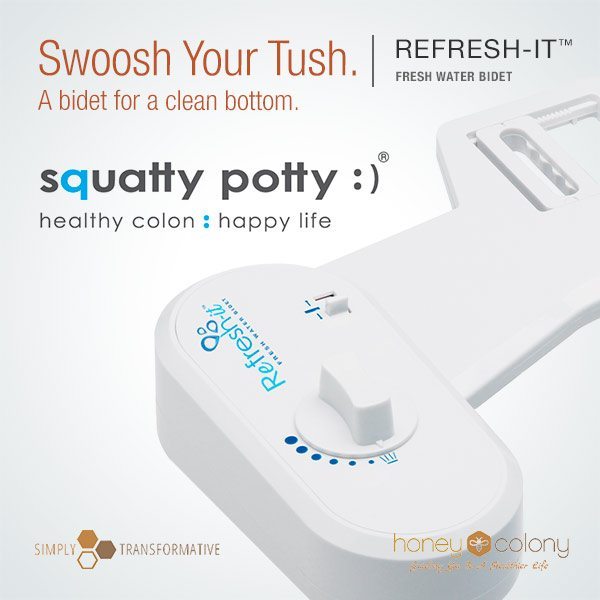Sharing is caring!
When it comes to our derrieres, America has always walked a conservative line. The first commercially viable toilet paper became available in 1857. By 1879, Scott Paper company was the only one offering rolled, perforated and ‘splinter-free’ (yikes!) toilet paper. Scott was so embarrassed about manufacturing toilet paper at the time that they actually took their name off the product.
Prior to this, the methods of cleaning after oneself were varied and strange. In America, people were using anything from corn cobs, newspapers, leaves, stones and fruit skins to lace and hemp, which was preferred by the wealthier elite around the world. Isn’t it unerringly strange that no one thought to utilize the same material that we use to clean the rest of our bodies?
In places as diverse as India, France and the Middle East, water has always been the first and most consistent method of cleaning oneself after a trip to the toilet.
Bidet For Your Bottom
Walk into any well-equipped bathroom in South America, Europe, or Asia and you will see a strange contraption sitting next to the toilet. It looks very similar to a toilet but does not have a lid or a seat and there are taps rather than a flushing mechanism. This commonly used bathroom fixture is called a bidet. Originating in the early 1700’s, the bidet has come a long way from its roots; furniture makers once created basins devised to house water for washing. Modern bidets are now sleek, adjustable appendages that fit directly onto your toilet. They operate by shooting jets of water upward and washing your private areas.
Today, many bidets come with functions such as a heated seat, a self-cleaning mode and a drying and deodorizing option. You can also control the temperature of the water with the touch of a button. Not a bad alternative to dried leaves and a corncob.
Bidets are useful tools for cleaning oneself, but can also provide benefits far and beyond basic self-care.
Here are 5 modern-day benefits of using a bidet:
1. Conserving Waste and Saving the Earth
A bidet is much less stressful on the environment than conventional toilet paper. At present, Americans use an average of 36.5 billion rolls of toilet paper a year, which results in the pulping of some 15 million trees. Significant amounts of energy, water, and other materials are used to sustain the toilet paper industry. By using a bidet, you can eliminate 90 percent of your toilet paper use. Most people use a very small amount of toilet paper to dry off after cleansing, some don’t use any at all. With our forests in such a perilous place, investing in a bidet seems like the choice to make for earth-conscious consumers.
2. Increased Cleanliness
Using only toilet paper to clean your bum pretty much guarantees that there will be some residue left. YUCK. Water is known as the universal solvent, which means it is much more effective at cleansing your skin. While enhanced personal hygiene is one added benefit of using a bidet, there is also another side to consider: a shocking 80 percent of all infectious diseases are passed on by skin-to-skin contact and only 50 percent of us wash our hands correctly after using the bathroom. Using a hands-free bidet would drastically decrease the number of germs that are being transmitted.
3. Therapeutic Effect on Skin
More and more Americans are turning to bidets because of the gentle nature of the device. For those with hemorrhoids or other sensitivities, toilet paper can often be much too harsh on contact. And for new mothers recovering from childbirth, a bidet is a great way to nurture the body’s healing process. Additionally, a large percentage of people suffer from skin sensitivities and allergies, which can be mitigated through the use of a bidet.
4. Septic System Friendly
Anyone with a toilet understands its ability to clog. It is one of the most undesirable things that can happen in your washroom. Conventional toilet paper can clog up your plumbing without any warning, especially if you are operating with an older septic system. Not only does a bidet save your consumption of toilet paper but it can also reduce the risk of an unsightly, overflowing toilet.
5. Cost-Effective and Easy to Use
Modern day bidets can be purchased for under $100. New designs make them easy to install and less invasive than previous models. Seniors, new mothers and those with medical conditions that limit mobility will find a bidet to be a welcome addition to their lives. HoneyColony offers Squatty Potty’s ReFresh-it Bidet a non-electrical solution, which is affordable and can easily be installed to your existing toilet.
Throughout the US, bidets are often seen as a foreign oddity—something to ponder over while traveling abroad. In our modern day world of gadgets and gizmos, it’s easy to get bogged down with the variety of exciting items available to us. However, taking care of our bodies and our personal hygiene should really rank among one of the most important tasks of our day-to-day life. Lately, more and more Americans are embracing the modernization of the bidet. After all, it is a cost-effective way to increase cleanliness, conserve waste and create a gentler, more efficient bathroom experience.
 Maya Bastian is a writer, a filmmaker, and an artist. Her wandering soul has taken her on many adventures and there are surely many more to come. Check her out online at www.mayabastian.com or follow her on Twitter and Instagram @mayabasti
Maya Bastian is a writer, a filmmaker, and an artist. Her wandering soul has taken her on many adventures and there are surely many more to come. Check her out online at www.mayabastian.com or follow her on Twitter and Instagram @mayabasti
Submit your story or essay to Buzzworthy Blogs.
- Tags: bidet, health, men's health, restroom, squatty potty, sustainability, women's health


